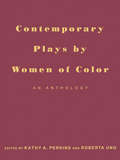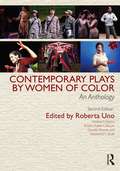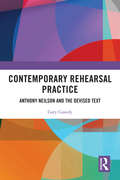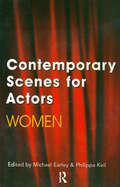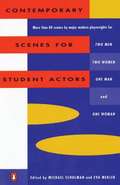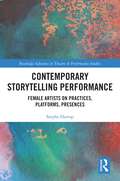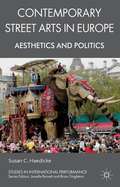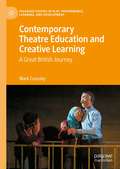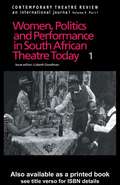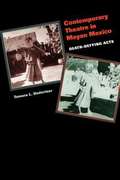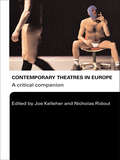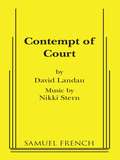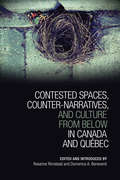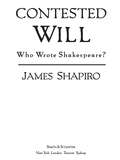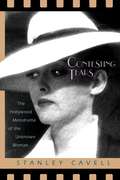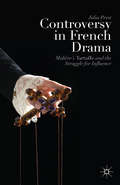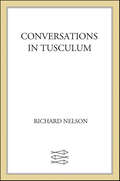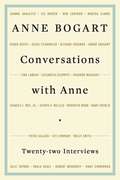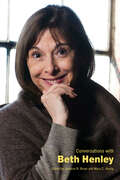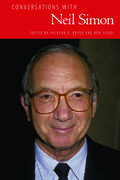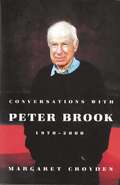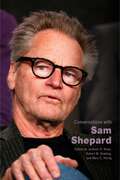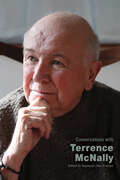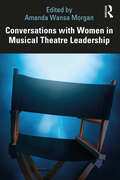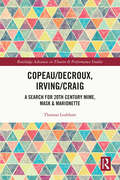- Table View
- List View
Contemporary Plays by Women of Color: An Anthology
by Roberta UnoContemporary Plays by Women of Color is a ground-breaking anthology of eighteen new and recent works by African American, Asian American, Latina American and Native American playwrights. This compelling collection includes works by award-winning and well-known playwrights such as Anna Deavere Smith, Cherrie Moraga, Pearl Cleage, Marga Gomez and Spiderwoman, as well as many exciting newcomers. Contemporary Plays by Women of Color is the first anthology to display such an abundance of talent from such a wide range of today's women playwrights. The plays tackle a variety of topics - from the playful to the painful - and represent numerous different approaches to playmaking. The volume also includes: * an invaluable appendix of published plays by women of color * biographical notes on each writer * the production history of each play Contemporary Plays by Women of Color is a unique resource for practitioners, students and lovers of theatre, and an inspiring addition to any bookshelf.
Contemporary Plays by Women of Color: An Anthology
by Roberta UnoIn the two decades since the first edition of Contemporary Plays by Women of Color was published, its significance to the theatrical landscape in the United States has grown exponentially. Work by female writers and writers of color is more widely produced, published, and studied than ever before. Drawing from an exciting range of theaters, large and small, from across the country, Roberta Uno brings together an up-to-date selection of plays from renowned and emerging playwrights tackling a variety of topics. From the playful to the painful, this revised and updated edition presents a rich array of voices, aesthetics, and stories for a transforming America.
Contemporary Rehearsal Practice: Anthony Neilson and the Devised Text
by Gary CassidyThis book provides the first comprehensive study of Anthony Neilson’s unconventional rehearsal methodology. Neilson’s notably collaborative rehearsal process affords an unusual amount of creative input to the actors he works with and has garnered much interest from scholars and practitioners alike. This study analyses material edited from 100 hours of footage of the rehearsals of Neilson’s 2013 play Narrative at the Royal Court Theatre, as well as interviews with Neilson himself, the Narrative cast, and actors from other Neilson productions. Replete with case studies, Gary Cassidy also considers the work of other relevant practitioners where appropriate, such as Katie Mitchell, Forced Entertainment, Joan Littlewood, Peter Brook, Complicite’s Simon McBurney, Stanislavski and Sarah Kane. Contemporary Rehearsal Practice will be of great interest to scholars, students and practitioners of theatre and performance and those who have an interest in rehearsal studies.
Contemporary Scenes for Actors: Women
by Michael Earley Philippa KeilFirst Published in 1999. Routledge is an imprint of Taylor & Francis, an informa company.
Contemporary Scenes for Student Actors
by Michael Schulman Eva MeklerCompiles more than eighty scenes by such modern playwrights as Williams, Slade, Miller, Zindel, and Feiffer for two men, two women, and one man and one woman.
Contemporary Storytelling Performance: Female Artists on Practices, Platforms, Presences (Routledge Advances in Theatre & Performance Studies)
by Stephe HarropThis book focuses on a rising generation of female storytellers, analysing their innovation in interdisciplinary collaboration, and their creation of new multimedia platforms for story-led performance. It draws on an unprecedented series of in-depth interviews with artists including Jo Blake, Xanthe Gresham-Knight, Mara Menzies, Clare Murphy, Debs Newbold, Rachel Rose Reid, Sarah Liisa Wilkinson, and Vanessa Woolf, while Sally Pomme Clayton’s reflections on her extraordinary four-decade career provide long-term context for these cutting-edge conversations. Blending ethnographic research and performance analysis, the book documents the working lives of professional storytelling artists. It sheds light on the practices, values, aspirations, and achievements of a generation actively re-defining storytelling as a contemporary performance practice, taking on topics from ecology and maternity to griefwork and neuroscience, while working collaboratively with diverse creative partners to generate new, inclusive presences for a traditionally-inspired artform. This book will be of great interest to students, scholars, and practitioners in drama, theatre, performance, creative writing, education, and media.
Contemporary Street Arts in Europe
by Susan C. HaedickeStreet theatre invades a public space, shakes it up and disappears, but the memory of the disruption haunts the site for audiences who experience it. This book looks at how the dynamic interrelationship of performance, participant and place creates a politicized aesthetic of public space that enables the public to rehearse democratic practices.
Contemporary Theatre Education and Creative Learning: A Great British Journey (Palgrave Studies In Play, Performance, Learning, and Development)
by Mark CrossleyThis book considers the state of contemporary theatre education in Great Britain is in two parts. The first half considers the national identities of each of the three mainland nations of England, Scotland, and Wales to understand how these differing identities are reflected and refracted through culture, theatre education and creative learning. The second half attends to 21st century theatre education, proposing a more explicit correlation between contemporary theatre and theatre education. It considers how theatre education in the country has arrived at its current state and why it is often marginalised in national discourse. Attention is given to some of the most significant developments in contemporary theatre education across the three nations, reflecting on how such practice is informed by and offers a challenge to conceptions of place and nation. Drawing upon the latest research and strategic thinking in culture and the arts, and providing over thirty interviews and practitioner case studies, this book is infused with a rigorous and detailed analysis of theatre education, and illuminated by the voices and perspectives of innovative theatre practitioners.
Contemporary Theatre Review: Women, Politics and Performance in South African Theatre Today (Contemporary Theatre Review Ser. #Vols. 9, Pts. 1.)
by Lizbeth GoodmanFirst published in 1999, 'Women, Politics and Performance in South African Theatre Today' is an important contribution to Performance.
Contemporary Theatre in Mayan Mexico: Death-Defying Acts
by Tamara L. UnderinerFrom the dramatization of local legends to the staging of plays by Shakespeare and other canonical playwrights to the exploration of contemporary sociopolitical problems and their effects on women and children, Mayan theatre is a flourishing cultural institution in southern Mexico. Part of a larger movement to define Mayan self-identity and reclaim a Mayan cultural heritage, theatre in Mayan languages has both reflected on and contributed to a growing awareness of Mayans as contemporary cultural and political players in Mexico and on the world's stage. In this book, Tamara Underiner draws on fieldwork with theatre groups in Chiapas, Tabasco, and Yucatán to observe the Maya peoples in the process of defining themselves through theatrical performance. She looks at the activities of four theatre groups or networks, focusing on their operating strategies and on close analyses of selected dramatic texts. She shows that while each group works under the rubric of Mayan or indigenous theatre, their works are also in constant dialogue, confrontation, and collaboration with the wider, non-Mayan world. Her observations thus reveal not only how theatre is an agent of cultural self-definition and community-building but also how theatre negotiates complex relations among indigenous communities in Mayan Mexico, state governments, and non-Mayan artists and researchers.
Contemporary Theatres in Europe: A Critical Companion
by Nicholas Ridout Joe KelleherThrough specific examples, case studies and essays by specialist writers, academics, and a new generation of theatre researchers, this collection of specially commissioned essays looks at current theatre practices across Europe. From Théatre du Soleil to Socìetas Raffaello Sanzio, the authors reconsider the possibilities of theatre practice, its relation to history and location and its place in Europe at the turn of the twenty-first century. Contemporary Theatres in Europe examines a wide range of topics including: mainstream European theatre experimental performance music theatre theatre for children dance theatre. Tailor-made for students, offering clear examples of different ways of thinking and writing about performance, this is a richly detailed introduction which brings key themes to life for all students of European theatre.
Contempt of Court
by David LandauFull Length / Interactive Comedy / 3m, 2f / Interior CONTEMPT OF COURT is a new non-mystery interactive comedy from the inventor of the interactive dinner theater. It's a typical night at Judge Judy's Peoples Night court where audience members become plaintiffs, defendants, witnesses and jury in some of the most outlandishly funny law suits ever to double cross the bench. This hilarious comedy send up of all those TV court shows proves that some people really have a Contempt of Court.
Contested Spaces, Counter-narratives, and Culture from Below in Canada and Québec
by Roxanne Rimstead Domenic A. BeneventiThis collection explores strategies of reading space and conflict in Canadian and Québécois literary and cultural performances. How do literary texts and popular cultural performances produce and contest spatial practices? What is the role of the nation, the city, the community, and the individual subject in reproducing space, even during times of global hegemony and neocolonialism? In what ways do marginalized individuals and communities represent, contest, or appropriate spaces through counter-narratives and expressions of culture from below? And how does space itself shape conflict, counter-memory, and culture from below? Focusing on contestation instead of harmony and consensus, Contested Spaces disturbs the idealized space of Canadian multicultural pluralism to carry literary analysis and cultural studies into spaces often undetected and unforeseen; Contested Spaces exposes geographies of exclusion and difference such as flophouses and "slums," shantytowns and urban alleyways, underground spaces and peep shows, inner city urban parks as experienced by minority ethnics, the poor, women, social activists, Indigenous people, and Francophones in Canada. These essays are the product of sustained and high-level collaboration across French and English academic communities in Canada to facilitate theoretical exchange on the topic of space and contestation, to expose geographies of exclusion, and to generate new spaces of hope in the spirit of pioneering work by Henri Lefebvre, Michel Foucault, Michel de Certeau, Doreen Massey, David Harvey, and other more recent theorists of space.
Contested Will: Who Wrote Shakespeare?
by James ShapiroFor more than two hundred years after William Shakespeare's death, no one doubted that he had written his plays. Since then, however, dozens of candidates have been proposed for the authorship of what is generally agreed to be the finest body of work by a writer in the English language. In this remarkable book, Shakespeare scholar James Shapiro explains when and why so many people began to question whether Shakespeare wrote his plays. Among the doubters have been such writers and thinkers as Sigmund Freud, Henry James, Mark Twain, and Helen Keller. It is a fascinating story, replete with forgeries, deception, false claimants, ciphers and codes, conspiracy theories--and a stunning failure to grasp the power of the imagination. As Contested Will makes clear, much more than proper attribution of Shakespeare's plays is at stake in this authorship controversy. Underlying the arguments over whether Christopher Marlowe, Francis Bacon, or the Earl of Oxford wrote Shakespeare's plays are fundamental questions about literary genius, specifically about the relationship of life and art. Are the plays (and poems) of Shakespeare a sort of hidden autobiography? Do Hamlet, Macbeth, and the other great plays somehow reveal who wrote them? Shapiro is the first Shakespeare scholar to examine the authorship controversy and its history in this way, explaining what it means, why it matters, and how it has persisted despite abundant evidence that William Shakespeare of Stratford wrote the plays attributed to him. This is a brilliant historical investigation that will delight anyone interested in Shakespeare and the literary imagination.
Contesting Tears: The Hollywood Melodrama of the Unknown Woman
by Stanley CavellWhat is marriage? Can a relationship dedicated to equality, friendship, and mutual education flower in an atmosphere of romance? What are the paths between loving another and knowing another? Stanley Cavell identified a genre of classic American films that engaged these questions in his study of comedies of remarriage, Pursuits of Happiness. With Contesting Tears, Cavell demonstrates that a contrasting genre, which he calls "the melodrama of the unknown woman," shares a surprising number and weave of concerns with those comedies. Cavell provides close readings of four melodramas he finds definitive of the genre: Letter from an Unknown Woman, Gaslight, Now Voyager, and Stella Dallas. The women in these melodramas, like the women in the comedies, demand equality, shared education, and transfiguration, exemplifying for Cavell a moral perfectionism he identifies as Emersonian. But unlike the comedies, which portray a quest for a shared existence of expressiveness and joy, the melodramas trace instead the woman's recognition that in this quest she is isolated. Part of the melodrama concerns the various ways the men in the films (and the audiences of the films) interpret and desire to force the woman's consequent inaccessibility. "Film is an interest of mine," Stanley Cavell has written, "or say a love, not separate from my interest in, or love of, philosophy. " In Contesting Tears Cavell once again brilliantly unites his two loves, using detailed and perceptive musings on melodrama to reflect on philosophical problems of skepticism, psychoanalysis, and perfectionism. As he shows, the fascination and intelligence of such great stars as Ingrid Bergman, Bette Davis, and Barbara Stanwyck illuminate, as they are illuminated by, the topics and events of these beloved and enduring films.
Controversy in French Drama: Molière’s Tartuffe and the Struggle for Influence
by Julia PrestIn 1664, Molière's Tartuffe was banned from public performance. This book provides a detailed, in-depth account of five-year struggle (1664-69) to have the ban lifted and, so doing, sheds important new light on 1660s France and the ancien régime more broadly.
Conversations in Tusculum: A Play
by Richard NelsonA riveting new work about power—and the abuse of power— in ancient Rome that has startling resonance with our age, Conversations in Tusculum reimagines the intense interaction among Brutus, Cassius, and Cicero leading up to the assassination of Julius Caesar, the leader they had once followed into battle but whom they have come to despise. Passionate in their beliefs but torn by their sense of loyalty, they struggle to continue believing in him despite their fear that his actions may pose great dangers to the nation. Conversations in Tusculum had its world premiere at the Public Theater in New York City in March 2008."Nelson…is a master of the quiet detail, of the oblique rhythm that transforms emotional diffidence into fascinating character."--Newsday
Conversations with Anne
by Anne BogartFrom one remarkable mind to another, Conversations with Anne documents the series of intimate interviews that theater director Anne Bogart has conducted-before live audiences-with major artists and cultural thinkers at her West Side studio over half a decade. In these extraordinary conversations, Bogart and her guests consider such free-ranging topics as the driving forces in their work, the paths their lives have taken, and their visions for the future of their field. Bogart delves into the daily thoughts of these artists and thinkers whom she most admires-a group that, collectively, has profoundly shaped the arts and artistry in America over the past twenty-five years.Interviewees include: JoAnne Akalaitis, Lee Breuer, Ben Cameron, Martha Clarke, Oskar Eustis, Zelda Fichandler, Richard Foreman, Andre Gregory, Bill T. Jones, Tony Kushner, Tina Landau, Elizabeth LeCompte, Eduardo Machado, Charles Mee, Joseph V. Melillo, Meredith Monk, Peter Sellars, Molly Smith, Elizabeth Streb, Julie Taymor, and Paula Vogel.Anne Bogart is artistic director of the SITI Company, which she founded with Japanese director Tadashi Suzuki in 1992. She has received two OBIE Awards, a Bessie Award, and a Guggenheim Fellowship, and is a professor at Columbia University, where she runs the Graduate Directing Program.
Conversations with Beth Henley (Literary Conversations Series)
by Jackson R. Bryer and Mary C. HartigWith roots in the American South, Beth Henley (b. 1952) has for four decades been a working playwright and screenwriter. Winner of the Pulitzer Prize in 1981 at the age of twenty-eight, Henley so far has written twenty-five produced plays that are always original, usually darkly comic, and often experimental. In these interviews, Henley speaks of the plays, from her early crowd-pleasers, Crimes of the Heart and The Miss Firecracker Contest, to her more experimental plays, including The Debutante Ball and Control Freaks, to her brilliant and time-bending play, The Jacksonian. Henley is a master at writing about the duality of human experience—the beautiful and the grotesque, the cruel and the loving. This duality provokes in Henley both amazement and compassion. She discusses here not only her admiration for Chekhov and other influences, but also her process of bringing a play from notebooks of images and bits of dialogues through rumination, writing, and rewriting to rehearsals and previews. The interviews range from 1981, just before she won the Pulitzer Prize, to 2020 and cover nearly forty years of a creative life, which, as Henley remarks in the most recent interview, is “such a life worth living: to be in tune with the creative process.”
Conversations with Neil Simon (Literary Conversations Series)
by Jackson R. Bryer and Ben SiegelNeil Simon (1927–2018) began as a writer for some of the leading comedians of the day—including Jackie Gleason, Red Buttons, Phil Silvers, and Jerry Lewis—and he wrote for fabled television programs alongside a group of writers that included Mel Brooks, Woody Allen, Larry Gelbart, Michael Stewart, and Sid Caesar. After television, Simon embarked on a playwriting career. In the next four decades he saw twenty-eight of his plays and five musicals produced on Broadway. Thirteen of those plays and three of the musicals ran for more than five hundred performances. He was even more widely known for his screenplays—some twenty-five in all. Yet, despite this success, it was not until his BB Trilogy—Brighton Beach Memoirs, Biloxi Blues, and Broadway Bound—that critics and scholars began to take Simon seriously as a literary figure. This change in perspective culminated in 1991 when his play Lost in Yonkers won the Pulitzer Prize for Drama. In the twenty-two interviews included in Conversations with Neil Simon, Simon talks candidly about what it was like to write commercially successful plays that were dismissed by critics and scholars. He also speaks at length about the differences between writing for television, for the stage, and for film. He speaks openly and often revealingly about his relationships with, among many others, Mike Nichols, Walter Matthau, Sid Caesar, and Jack Lemmon. Above all, these interviews reveal Neil Simon as a writer who thought long and intelligently about creating for stage, film, and television, and about dealing with serious subjects in a comic mode. In so doing, Conversations with Neil Simon compels us to recognize Neil Simon’s genius.
Conversations with Peter Brook: 1970-2000
by Margaret Croyden Peter Brook"A fascinating and provocatively stimulating distillation of three decades of intense conversations between one of the twentieth century's few true theater innovators and America's leading writer on the theatrical avant-garde. A splendid book."--Clive Barnes"Peter Brook continues to astonish, not in an ordinary, fashionable way, but in an ancient, insistent way that always forces one inward. There is a true, honest, fearless voice in this fascinating conversation."--Ken BurnsPeter Brook, one of the most important contemporary theatrical directors in the West, shares his most insightful thoughts and deepest feelings about theater with Margaret Croyden, who has followed his career for thirty years, gaining an unparalleled perspective on the evolution of his work. In these interchanges from 1970 to 2000, Brook freely discusses major works such as his landmark airborne A Midsummer Night's Dream and his untraditional interpretation of the opera La Tragédie de Carmen. He also covers the establishment of the Paris Center, his work in the Middle East and Africa, and his masterwork, the nine-hour production of The Mahabharata, which has virtually reinvented the way actors and directors think about theater.Margaret Croyden is a well-known critic, commentator, and journalist, whose articles on theater and the arts have appeared in The New York Times, The Nation, The Village Voice, American Theatre, and Antioch Review, among others. She is the author of Lunatics, Lovers and Poets, a seminal book on the development of nonliterary theater.
Conversations with Sam Shepard (Literary Conversations Series)
by Jackson R. Bryer, Robert M. Dowling, and Mary C. HartigA prolific playwright, Sam Shepard (1943–2017) wrote fifty-six produced plays, for which he won many awards, including a Pulitzer Prize. He was also a compelling, Oscar-nominated film actor, appearing in scores of films. Shepard also published eight books of prose and poetry and was a director (directing the premiere productions of ten of his plays as well as two films); a musician (a drummer in three rock bands); a horseman; and a plain-spoken intellectual. The famously private Shepard gave a significant number of interviews over the course of his public life, and the interviewers who respected his boundaries found him to be generous with his time and forthcoming on a wide range of topics. The selected interviews in Conversations with Sam Shepard begin in 1969 when Shepard, already a multiple Obie winner, was twenty-six and end in 2016, eighteen months before his death from complications of ALS at age seventy-three. In the interim, the voice, the writer, and the man evolved, but there are themes that echo throughout these conversations: the indelibility of family; his respect for stage acting versus what he saw as far easier film acting; and the importance of music to his work. He also speaks candidly of his youth in California, his early days as a playwright in New York City, his professionally formative time in London, his interests and influences, the mythology of the American Dream, his own plays, and more. In Conversations with Sam Shepard, the playwright reveals himself in his own words.
Conversations with Terrence McNally (Literary Conversations Series)
by Raymond-Jean FrontainArriving in New York at the tail end of what has been termed the “Golden Age” of Broadway and the start of the Off-Broadway theater movement, Terrence McNally (1938–2020) first established himself as a dramatist of the absurd and a biting social critic. He quickly recognized, however, that one is more likely to change people’s minds by first changing their hearts, and—in outrageous farces like The Ritz and It’s Only a Play—began using humor more broadly to challenge social biases. By the mid-1980s, as the emerging AIDS pandemic called into question America’s treatment of persons isolated by suffering and sickness, he became the theater’s great poet of compassion, dramatizing the urgent need of human connection and the consequences when such connections do not take place. Conversations with Terrence McNally collects nineteen interviews with the celebrated playwright. In these interviews, one hears McNally reflect on theater as the most collaborative of the arts, the economic pressures that drive the theater industry, the unique values of music and dance, and the changes in American theater over McNally’s fifty-plus year career. The winner of four competitive Tony Awards as the author of the Best Play (Love! Valour! Compassion! and Master Class) and author of the book for the Best Musical (Kiss of the Spider Woman and Ragtime), McNally holds the distinction of being one of the few writers for the American theater who excelled in straight drama as well as musical comedy. In addition, his canon extends to opera; his collaboration with composer Jake Heggie, Dead Man Walking, has proven the most successful new American opera of the last twenty-five years.
Conversations with Women in Musical Theatre Leadership
by Amanda Wansa MorganMost writers, composers, librettists, and music directors who make their careers in musical theatre do so without specific training or clear pathways to progress through the industry. Conversations with Women in Musical Theatre Leadership addresses that absence by drawing on the experiences of these women to show the many and varied routes to successful careers on, off, and beyond Broadway. Conversations with Women in Musical Theatre Leadership features 15 interviews with Broadway-level musical theatre music directors, directors, writers, composers, lyricists, stage managers, orchestrators, music arrangers, and other women in positions of leadership. Built around extensive interviews with women at the top of their careers in the creative and leadership spheres of musical theatre, these first-hand accounts offer insight into the jobs themselves, the skills that they require, and how those skills can be developed. Any students of musical theatre and stagecraft, no matter what level and in what setting from professional training to university and conservatory study, will find this a valuable asset.
Copeau/Decroux, Irving/Craig: A Search for 20th Century Mime, Mask & Marionette (Routledge Advances in Theatre & Performance Studies)
by Thomas G LeabhartIn this series of essays, Thomas Leabhart presents a thorough overview and analysis of Etienne Decroux’s artistic genealogy. After four years’ apprenticeship with Decroux, Thomas Leabhart began to research and discover how forebears and contemporaries might have influenced Decroux’s project. Decades of digging revealed striking correspondences that often led to adjacent fields—art history, philosophy, and anthropology—forays wherein Leabhart’s appreciation of Decroux and his "kinsfolk," who themselves transgressed traditional frontiers, increased. The following essays, composed over a 30-year period, find a common source in a darkened Prague cinema where people gasped at a wooden doll’s sudden reversal of fortune. These essays: investigate the source of that astonishment; continue Leabhart's examination of Decroux’s "family tree"; consider how Copeau's and Decroux's keen observation of animal movement influenced their actor training; record the challenging and paradoxical improvisations chez Decroux; and recall Decroux’s debt to sculpture, poster art, sport and masks. These essays will be of great interest to students, scholars and practitioners in theatre and performance studies.
